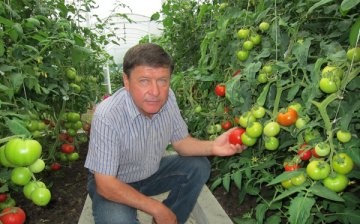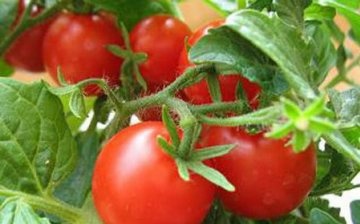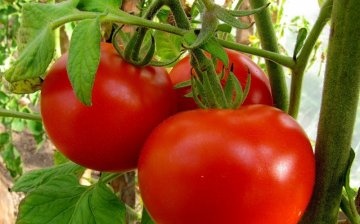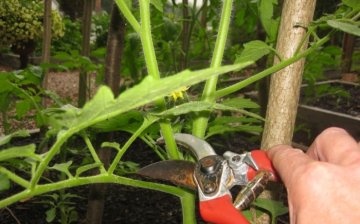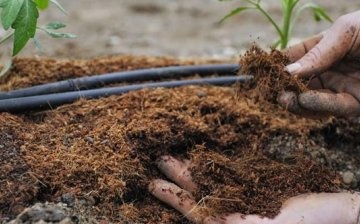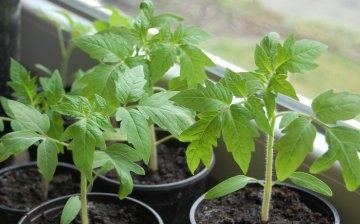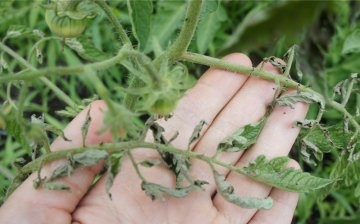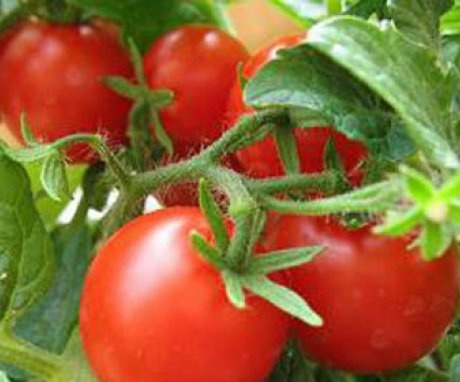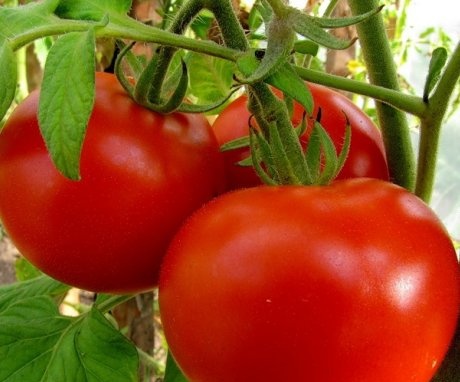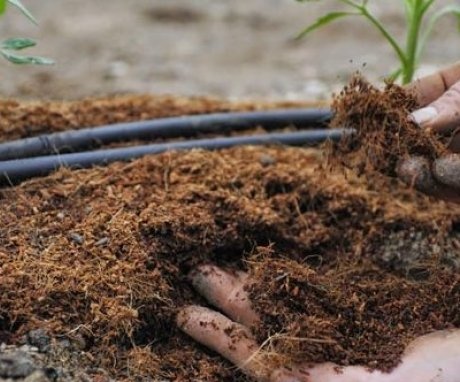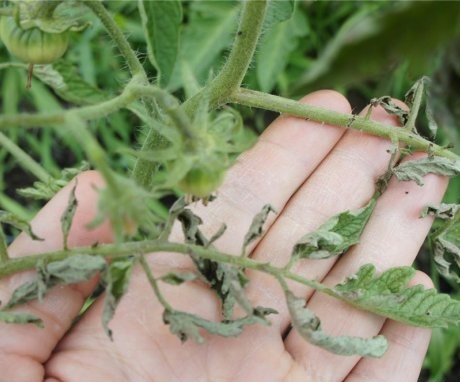How to care for tomatoes in a greenhouse - watering, feeding and pinching
Tomatoes have been used in food for many decades. Growing it in a country house or a personal plot is a familiar thing. Many gardeners plant tomatoes in greenhouses to get a tasty product not only during the season, but also during other times of the year.
Content:
- General information about tomatoes
- The best varieties for greenhouses
- Pruning and watering
- Top dressing and pollination
- Reproduction methods
- Disease prevention
General information about tomatoes
A tomato Is a herb that belongs to the nightshade family. It grows in the form of a single-stemmed herbaceous bush, the height of which can reach 2 meters. Its branches are spreading, the stems are thick, strong, painted in a greenish tone and covered with a silvery bloom. Leaves are not densely located on the trunk and branches on cuttings. Embossed, with a sharp end and sparse jagged edges.
The flowers are small in size, composed of petals, which are colored yellow. After pollination, the fruits are set. Their size and color depends on the variety. tomato... In its modern form, you can find red, yellow, orange, pink, green, blue, black and other colored tomatoes, which will differ in taste and juiciness.
The shape and size also ranges from small and round to huge, oval or pear-shaped.
Due to the fact that tomatoes can be grown in greenhouses, many gardeners plant popular varieties in the fall in erected greenhouses. This makes it possible to use fresh fruits almost all year round.
The best varieties for greenhouses
Breeders all over the world have bred many varieties of tomatoes for cultivation in a greenhouse with different soil compositions and in different regions. You can pick up tall bushes, medium varieties or very small plants, depending on your needs.
Description of varieties:
- Cherry red. It is a variety with small fruits that ripen on a cluster slightly similar to that of a grape. Bushes of medium height, compact, productive. Such a variety can be grow both in greenhouses and in the open field. Fruits are small, round, colored red.
- Miracle of the earth. The bushes are large, the branches are strong and spreading. The variety is high-yielding, from one bush you can collect 4.5-5 kilograms of tomato. The fruits are large, oval, red in color and the top rind and pulp. The weight of one tomato can reach 1 kilogram.
- Mandarin duck. Greenhouse variety of early ripening tomatoes. Fruits can be harvested as early as 3 months after germination. Bushes of medium size, spreading. Fruits are juicy, tasty, and can be grown outdoors.
- Meal. This variety was developed by breeders to grow only in greenhouse conditions. It can be classified as early maturing. Fruits can be harvested as early as 2.5 months after germination.
Pruning and watering
To grow in a greenhouse good harvest tomatoes need to work hard to create the necessary conditions. Proper care, adequate lighting and constant warmth and humidity give growth not only to fruiting plants, but also to bacteria that cause various fungal and other diseases... Therefore, the health of such plants is closely monitored and the soil and tomato bushes are treated with special preparations in a timely manner.
Rules for planting tomatoes in a greenhouse:
- Before planting seedlings in the greenhouse, it is necessary to prepare the territory and soil.If something grew in the greenhouse in the previous year, then the top layer is completely removed, and a new, fertile one is filled in instead. Humus, peat and sawdust should be present in the new soil. You can also add mineral fertilizers and organics.
- Before planting a tomato, it is necessary to water the entire area with a solution of potassium permanganate, heated to 50 degrees, for disinfection and disinfection of the soil.
- Next, you need to prepare the holes, each gardener digs them up at his own discretion. The distance between the holes depends on the variety of tomato and the height of the bush, and it ranges from 30 cm to 80 cm.
For stable growth and proper development of the plant in the greenhouse, it is necessary to maintain the temperature. In the daytime, it should be within 25-25 degrees, at night not lower than 15 degrees. Humidity should be maintained at the required level and not exceed 65%. From time to time, in good and sunny weather, the greenhouse needs to be ventilated, this will help get rid of dampness and prevent some diseases.
Watering:
- For glaze it is recommended to install a drip irrigation system in the greenhouse. This will save the plants from excess moisture, save water and time.
- The amount of water introduced depends on the quality of the soil and the degree of its drying out.
- During the fruiting period, watering is increased.
1 week after planting seedlings it is necessary to tie each bush to the support. This process is carried out so that the bushes do not break or fall under the weight of the fruits, since due to high humidity, rotting of the fruit can begin when it comes into contact with the soil.
It is also important for greenhouse tomatoes to carry out pinching - removal of excess branches that form in the axils of leaf cuttings.
In this case, they must be broken off, leaving small stumps. This process is carried out regularly so that the thickening of the bush and the entire planting does not take place. As in normal conditions, when growing tomatoes in greenhouses, the soil must be loosened regularly. This process can be carried out some time after watering to allow excess water to drain away and to get additional air for the roots.
Top dressing and pollination
In natural conditions, when growing tomatoes in open ground, pollination is carried out naturally with the help of insects. In greenhouse conditions, this process has to be done manually. To do this, you need to choose a sunny warm day.
Shake each flowering bush a little, hooking the trellis or wire to which it is tied.
In conditions of high humidity, pollen falls out of the anthers poorly, and this will help it to freely emerge from the anthers. After that, it is recommended to spray the plants from above so that the pollen sticks better and begins to germinate. It is also necessary to ventilate the greenhouse by opening all passages and windows 2 hours after spraying. This will reduce moisture and dampness.
Top dressing:
- After seedling planted in the soil of the greenhouse, it is necessary to carry out 3-4 fertilizing within 1.5 months.
- After 3 weeks, organic fertilizers and nitrophoska, each bush should receive 1-1.5 liters of such a solution.
- Next, you need to apply mineral fertilizers for intensive growth and flowering.
- When an ovary has appeared on the bushes, and the fruits begin to grow, it is recommended to add 1 more portion of fertilizer, which consists of superphosphate and sodium humate.
Reproduction methods
Reproduction tomatoes are produced ubiquitously using seed... For planting plants in a greenhouse, special varieties are selected that are adapted for such conditions. If the seeds are purchased or received as a gift, it is recommended to process them before sowing. Such procedures will prevent seedling diseases and increase the percentage of germination.
Reproduction by seeds:
- The seeds are treated with a weak manganese solution and soaked in water. You can also carry out the cooling procedure by keeping them at a temperature of 2 degrees Celsius for 1-2 days.
- Seeds are sown in previously prepared high containers filled with peat, turf and humus mixed in equal parts. It is also recommended to add wood ash, superphosphate and pre-calcined river sand to the substrate. This will give the sprouts additional nutrition.
- In well-tamped soil, small depressions are made with lines into which the seeds are laid out.
- Next, the crops are watered and sprinkled on top with the same substrate.
- The box is placed in a well-lit place with an ambient temperature of 22 degrees.
- To speed up the pecking of seeds, you can build a greenhouse over the container using glass or film. This is done only 5-7 days after sowing.
When 2-3 adult leaves appear on small sprouts, they are necessary dive in separate containers. For this, the substrate is well watered, and each individual bush is removed along with a lump of earth. Peat cups can be used as containers, which, after planting in a greenhouse, will provide additional nutrition to the plant.
Disease prevention
Pests practically do not appear in greenhouse conditions, mainly such tomato grown in the cold season, when all insects are dormant. But diseases can arise from both improper care and high humidity:
- If flowers begin to fall off the bushes, this is an indicator of dry air and a lack of moisture in the soil. If such a case is found, it is recommended to immediately water all the plantings well and ventilate the greenhouse well, allowing fresh air to balance the microclimate. Also increase the humidity level.
- If the bushes grow too quickly, and the tops of a rich green color are juicy and rich, this is an indicator that the plant takes a lot of nutrients and spends them on growing branches, and not fruits. This often happens when there is a lack of lighting and low temperatures. In this case, it is necessary to add sunlight and increase the degrees by 2-3 upwards, if the period is cloudy, then strengthen the artificial lighting. You can also feed the bushes with a superphosphate solution.
- Fruit cracking can occur with severe watering after a long drought. Therefore, it is necessary to monitor the introduction of water into the soil, carry out this process as necessary and only at the root, so as not to stimulate the development of dampness.
- Root rot can occur with improper or careless transplantation seedlings... If the main root is damaged, then the plant begins to receive less nutrients and moisture, grows more slowly and dries up over time. Therefore, when transplanting, it is best not to touch the roots, but to remove them from the containers along with the earthen clod, or use peat cups and plant with them. Also, the roots can be damaged when loosening the earth.
- In conditions of high humidity, if the greenhouse is rarely ventilated, a fungal disease late blight may occur. It manifests itself in the form of darkened leaves and fruits. If this ailment is found, it is recommended to treat the plant with lactic acid.
- Top rot can also appear in tomatothat are grown in the greenhouse. The reason for this can be both high humidity and drying out of the air. It appears as a black dried spot on the fruit. It is necessary to regularly examine the fruits and, if such marks are found, they are plucked from the bush. To carry out preventive actions, gardeners recommend adding calcium to the soil using ash or crushed eggshells.
More information can be found in the video.



